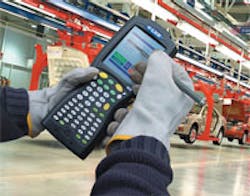Many foundries have become so accustomed to paperwork that they don’t realize it is a productivity hurdle. Information bottlenecks caused by paperwork decreases the potential benefit a maintenance manager could gain from being able to view real-time assignments and status of work orders.
Manual, or paper, systems present a variety of problems. For starters, workflow is inefficient, as workers may have multiple trips to administrative offices to handle paperwork. Data entry is a time-consuming process, transferring the written record to a system, sometimes involving multiple individuals. And, the information can be incomplete because individuals may shorten or completely disregard items that they don’t feel is important, or the integrity of the information is compromised because of when it is logged in.
By adopting mobile technology for their technicians and operators, in conjunction with a CMMS (Computerized Maintenance Management System), metalcasters can realize a host of benefits, starting with the elimination of paperwork. The CMMS provides technicians with more information at the point of performance, allows for faster troubleshooting and maintenance, simplifies access to equipment history, and helps with compliance issues.
Multifunction advantages
Additionally, CMMS makes it possible to capture work completion data to enhance management functions, including better reporting, better planning, reduced maintenance backlog, and an increase in overall life of critical assets.
Using mobile technology in conjunction with CMMS can help in a variety of areas. The equipment collects data, such as pressure, temperature, amps, and oil levels, all on the handheld device. The devices also performs inspection routes and calibration checks.
Work orders can be dispatched on the devices. Maintenance technicians can perform the actual work with instructions, enter time-taken or work-performed details, and close the work orders right on the handheld. The information is transferred into CMMS, either in real time or, later, via synchronizing. The work orders can be generated in the field on the devices, establishing a completely paperless work order system if desired.
Parts inventory can be tracked on the CMMS. Receiving, addition and depletion, cycle counts, and annual physical inventory all can be done efficiently using the handheld devices.
Devices, software, and wireless
CMMS technology is separated into three categories. Mobile devices are the primary component of the application. These include PDAs (pocket PCs, cell phones, etc.), tablet PCs, laptops, or netbooks. These devices carry much more information than is possible in paper-based systems, complete work orders faster and more accurately, and transmit data back into CMMS faster. They are also light and easy to carry, and relatively inexpensive.
Another category is software applications, which enable developers to create electronic forms, transforming key data from CMMS applications into usable work orders that make it easier to view on handheld devices, and create an easy-tofollow workflow. Mobile software integrates directly with existing CMMS, and enables technicians to pull data directly from the CMMS and to update information remotely. It also manages the synchronization of data between the devices and the application database. And, standard procedures, such as making it mandatory for technicians to enter failure codes before closing work orders, can be implemented. +The final category is wireless access, allowing for the immediate transport of data. There are different options to achieve wireless network access: wide area wireless or wireless LANs (WiFi).
Bar codes and RFIDs
Users can take further advantage of the mobility of CMMS by using bar codes and RFIDs. All the previously mentioned functions can be made even more efficient by using bar codes for data entry. Instead of entering equipment numbers into the handheld device, users can scan the bar code and retrieve the information. Although RFID solutions are expensive to implement, those costs should decrease as the use of RFIDs expands.
Mobile computing offers a proven solution for access to equipment history and repair information to the maintenance technicians on the move. With handheld devices becoming lighter, more affordable, and more powerful, metalcasters must take advantage of this technology to improve their productivity.
| Kris Bagadia, president of PEAK Industrial Solutions, is a consultant and educator in the field of maintenance management. Contact him at [email protected], or Tel. 414-732-8645. |
